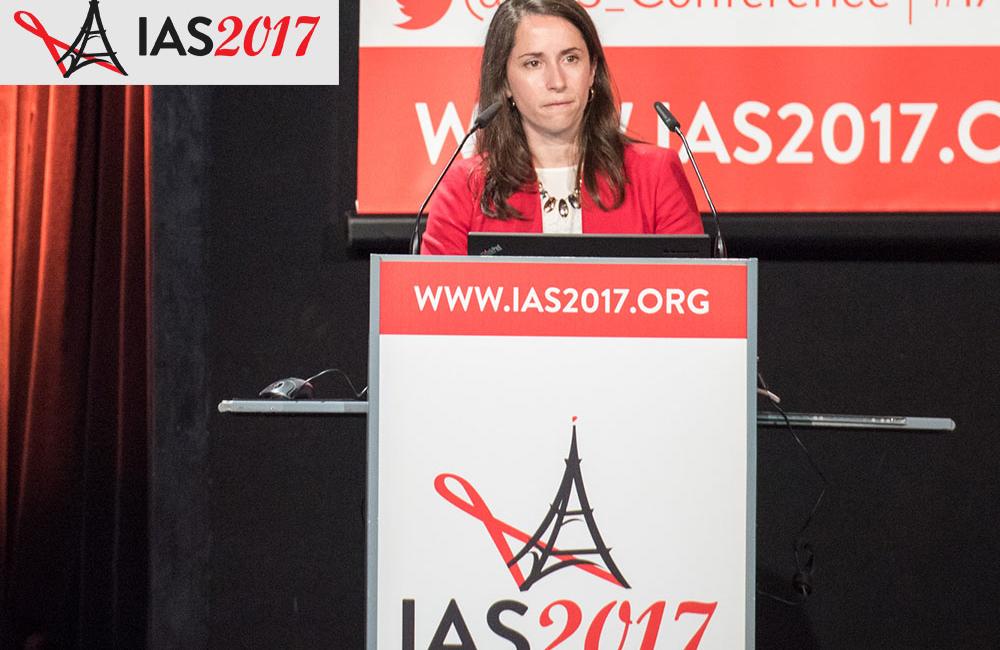
Dolutegravir-based antiretroviral therapy (ART) started in pregnancy is as safe as efavirenz-based ART, according to a study of birth outcomes at eight maternity wards throughout Botswana accounting for close to half of all nationwide deliveries, Rebecca Zash of Beth Israel Deaconess Medical Center told participants on Monday at the 9th International AIDS Society Conference on HIV Science (IAS 2017).
And, a French study of birth outcomes in women exposed to raltegravir during pregnancy found no excess risk of adverse birth outcomes compared to other antiretroviral regimens.
Dolutegravir and raltegravir are HIV integrase inhibitors and the drugs are being prescribed more frequently as preferred options for first-line treatment. The findings presented this week are the first large surveys of adverse birth outcomes in women exposed to either drug.
Dolutegravir and birth outcomes in Botswana
In 2016 the World Health Organization added dolutegravir, an integrase inhibitor, to its HIV treatment guidelines as an alternative first-line ART for adults and adolescents over 12 years of age.
Due to its potency, improved tolerability and higher barrier to drug resistance dolutegravir provides better clinical benefits compared to another integrase inhibitor, raltegravir (the safety in pregnancy of the latter is discussed below). Switching to dolutegravir from an efavirenz-based first-line ART, the most common regimen used in pregnancy in high-burden countries, may also be cost-effective because relatively less active pharmaceutical ingredient is needed to make it.
So, many countries are moving to a dolutegravir-based ART as a first-line recommended regimen.
However, the lack of a sufficient evidence base for safety and efficacy of dolutegravir (among other new antiretrovirals) means its introduction as the preferred first-line option is being approached cautiously in many low- and middle-income countries. Importantly, more evidence is needed on safety during pregnancy and breastfeeding.
In 2016 Botswana changed first-line ART from the efavirenz-based regimen to the dolutegravir-based option including for pregnant women.
At the 2016 Conference on Retroviruses and Opportunistic Infections (CROI) this year Dr Zash presented findings from a two-year analysis of a study (Tsepamo) showing that an efavirenz-based regimen in pregnancy was safer than four older ART regimens. The differences in birth outcomes were significant with a 6 to 12% lower prevalence for any adverse outcomes and a 6 to 11% lower prevalence for severe adverse outcomes.
With the change in Botswana national guidelines Dr Zash and her colleagues were able to perform a dolutegravir analysis within the Tsepamo study.
Outcomes comprised combined endpoints of any adverse outcomes that included: stillbirth, preterm birth [less than 37 weeks], SGA [small for gestational age – below the 10th percentile weight-for-gestational age], or neonatal death [less than 28 days old]; and severe adverse outcomes that included: stillbirth, neonatal death, very preterm birth [less than 32 weeks] and very SGA [below the 3rd percentile weight-for-gestational age].
Maternal characteristics including age, education, occupation, parity, alcohol/tobacco use, history of adverse birth outcomes, delivery site, gestational age at presentation for antenatal care and CD4 count were very similar in women starting either the dolutegravir- or efavirenz-based regimen.
ART was started at a median of 19 weeks (IQR: 15-25) and 21 weeks (IQR: 16-27) into the pregnancy among those on the dolutegravir- and efavirenz-based regimens, respectively.
Comparison of women taking dolutegravir/tenofovir/emtricitabine (DTG/TDF/FTC) (who delivered from November 2016 to April 2017) with those taking efavirenz/tenofovir/emtricitabine (EFV/TDF/FTC) (who delivered from August 2014 to 2016) showed no significant differences in stillbirth, neonatal death, preterm or very preterm birth, SGA or very SGA.
Just over a third in both the DTG/TDF/FTC (n = 845) and EFV/TDF/FTC (n = 4593) groups had a combined endpoint of any adverse birth outcomes, 291 (34%) and 1606 (35.%), respectively, (adjusted relative risk (aRR): 1.0, 95% CI: 0.9-1.1).
Eleven per cent of infants in both groups had a combined endpoint of severe adverse outcomes, 92 and 519 in the DTG/TDF/FTC and EFV/TDF/FTC groups, respectively, (aRR: 1.0, 95%: CI: 0.8-1.2).
Just over 2% experienced stillbirth, 18 (2.1%) and 105 (2.3%) among those on the dolutegravir- and efavirenz-based regimens, respectively, aRR: 0.9, 95% CI: 0.6-1.5). Neonatal death occurred in 1.3% in both groups.
The findings for preterm birth are similar, 18% and 19% among infants born to mothers starting dolutegravir- and efavirenz-based regimens in pregnancy, respectively and 4% for very preterm births for both regimens.
Similarly, 19% of women on both regimens had an infant SGA while 6% and 7% of women on dolutegravir- and efavirenz-based regimens, respectively, had an infant that was very small for its gestational age (very SGA).
Among the infants of the 512 women (116 DTG/TDF/FTC and 396 EFV/TDF/FTC) who started ART in the first trimester only one major congenital abnormality was identified, namely skeletal dysplasia in an efavirenz-exposed infant. This is very preliminary given the small number.
Dr Zash concluded while these findings are very reassuring further studies are needed to look at the safety of dolutegravir exposure from conception, congenital abnormalities, combinations with other antiretroviral backbones and maternal viral load at delivery.
Raltegravir safety
Dr Jeanne Sibiude presenting findings, on behalf of the ANRS-French Perinatal Cohort (EPF), from the largest prospective cohort study of children exposed to raltegravir during pregnancy yet studied found no evidence of an association between birth defects and exposure to raltegravir.
In France increasing numbers of women are prescribed a wide range of antiretrovirals from conception, of which raltegravir accounts for approximately 10%.
There is no published literature on the association of exposure to raltegravir and birth defects. There is evidence of the placental transfer of raltegravir.
Begun in 1985 EPF, a multicentre (100 sites) national ongoing prospective cohort enrols all pregnant HIV-infected women with an estimated 70% coverage. Paediatricians follow uninfected children up until two years of age and infected children until 18.
All children exposed to raltegravir during pregnancy were included. Rates and types of birth defects were compared according to the timing of exposure (first trimester compared to second and third trimesters).
Of the 479 raltegravir-exposed infants born between 2008 and 2015 there were six (1.3%) stillbirths and two (0.4%) late miscarriages.
Preterm births accounted for 14.2% (68) of births and there were two cases (0.4%) of HIV perinatal infection.
Rates of birth defects were 4.2% for all births and 4.2% among live births. This compares with a previous EPF study of 4.4% for live births of infants exposed to any antiretroviral drug during pregnancy.
Birth defect rates did not differ significantly between first trimester exposure and second and third trimester exposure to raltegravir, 5.7% (8/140), and 3.5% (12/339) respectively; odds ratio (OR: 1.6, 95% CI: 0.7-4.1), p = 0.29.
Dr Sibuide concluded these findings provide reassurance to those young women prescribed raltegravir who have few alternative treatment options.
Continuous epidemiological surveillance of new drugs and the risk for birth defects is needed, she added.
Zash R et al. Dolutegravir/tenofovir/emtricitabine (DTG/TDF/FTC) started in pregnancy is as safe as efavirenz/tenofovir/emtricitabine (EFV/TDF/FTC) in nationwide birth outcomes surveillance in Bostwana, 9th International AIDS Society Conference on HIV Science, Paris, abstract MOAX0202LB, July 2017.
View the abstract on the conference website.
Download the presentation slides from the conference website.
Watch the webcast of this session on YouTube.
Sibiude J et al. Evaluation of the risk of birth defects among children exposed to raltegravir in utero in the ANRS-French Perinatal Cohort EPF, 9th International AIDS Society Conference on HIV Science, Paris, abstract MOAB0204, July 2017.
View the abstract on the conference website.
Download the presentation slides from the conference website.

